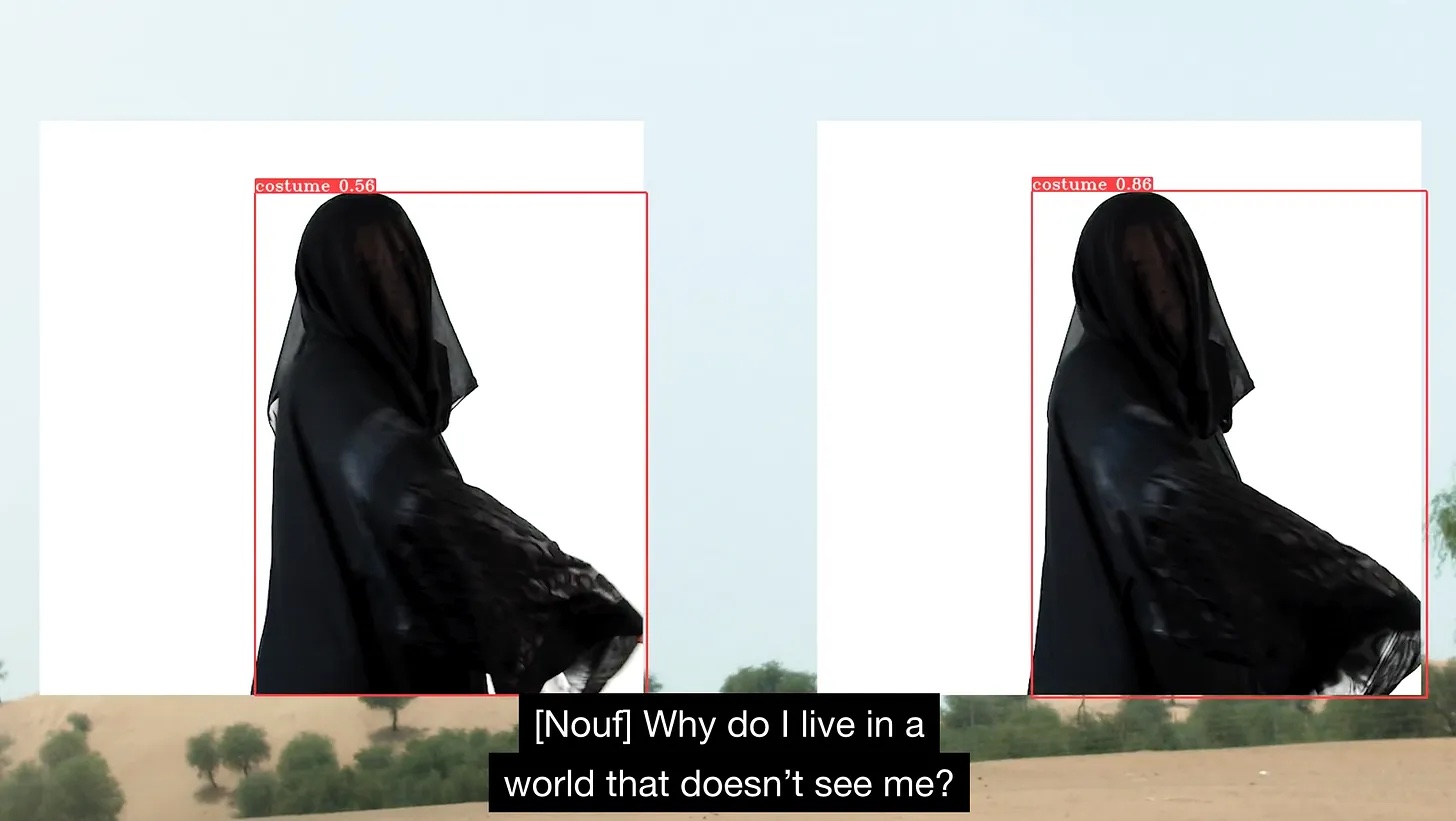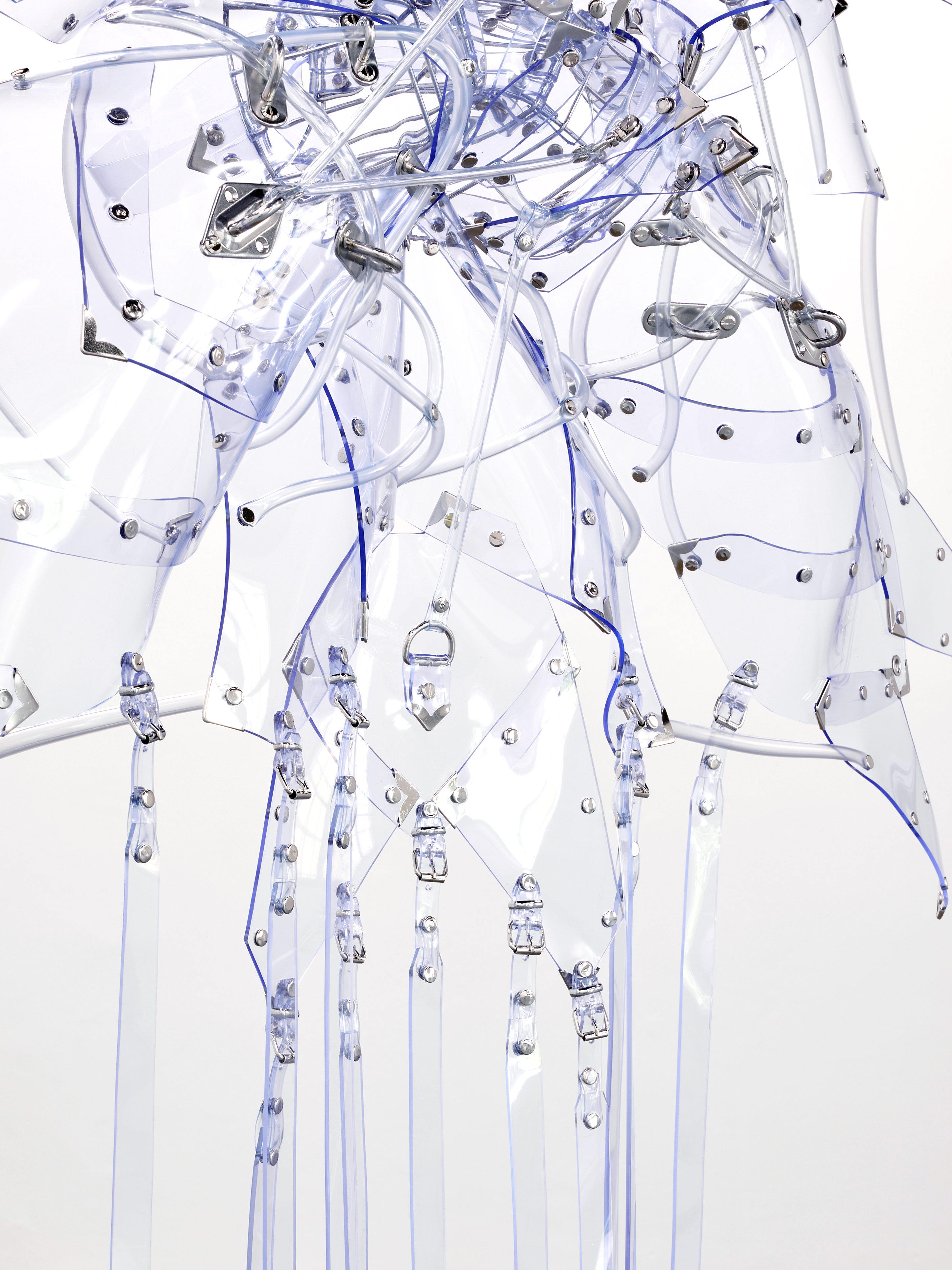

Stills from Ana Min Wein (Where am I From?) by Nouf Aljowaysir
Enduring AI Power Structures: Nuance and System Fragility
Current capabilities in training neural networks are streamlined for Western and capitalist demands—profit, consumption, production, speed, efficiency, perfection. How else, outside of what we are being administered by tech giants, the media, and the West, could they be opened up and used? What stories are at risk of being lost? How might cultural erasure be perpetuated by these technologies?
Read more on Do Not Research...
Current capabilities in training neural networks are streamlined for Western and capitalist demands—profit, consumption, production, speed, efficiency, perfection. How else, outside of what we are being administered by tech giants, the media, and the West, could they be opened up and used? What stories are at risk of being lost? How might cultural erasure be perpetuated by these technologies?
Read more on Do Not Research...

Floryan Varennes, Matriarche (detail), 2022, Muzzles, Medical tubes, Medical PVC vinyl, Stainless steel fasteners, rings, rivets Medical instruments, 160 x 160 cm
Floryan Varennes: Allegory for a More Sensitive Future
Speculating on futures that bypass the portrayal of forcibly utopian or dystopian outcomes, Floryan Varennes instead chooses to remain a realist. Both an artist and medieval historian, he looks to protection systems and ancestral remedies from the Middle Ages, as well as contemporary institutional care and science fiction. His use of this historical continuum allows him to focus on different facets of the term care and how these sensibilities could potentially improve the body, mind, and society. Learning from these themes and looking through them as if they were lenses, he peers squarely into the face of the world as it is today, absorbing and critiquing its problems as well as its beauty. Societal realities and challenges such as queer and gender politics, bioethics, ecology, modern romance, and war all rest at the core of his sculptures, videos, and installations.
Read more on XIBT...
Speculating on futures that bypass the portrayal of forcibly utopian or dystopian outcomes, Floryan Varennes instead chooses to remain a realist. Both an artist and medieval historian, he looks to protection systems and ancestral remedies from the Middle Ages, as well as contemporary institutional care and science fiction. His use of this historical continuum allows him to focus on different facets of the term care and how these sensibilities could potentially improve the body, mind, and society. Learning from these themes and looking through them as if they were lenses, he peers squarely into the face of the world as it is today, absorbing and critiquing its problems as well as its beauty. Societal realities and challenges such as queer and gender politics, bioethics, ecology, modern romance, and war all rest at the core of his sculptures, videos, and installations.
Read more on XIBT...

Samuel Fosso, Autoportrait Série « 70’s Lifestyle », 1975-78
© Samuel Fosso. Courtesy Jean-Marc Patras / ParisProfile: Samuel Fosso
Samuel Fosso opened his first photography studio when he was only thirteen years old in Bangui, the capital of the Central African Republic. At this point, he had already completed a six month apprenticeship where he learned how to use a camera, as well as develop and print photographs himself. He took pictures of clients during the day and began experimenting with extra film he had leftover after closing time. Turning the room into a one man show, Fosso made his studio a safe space where he would playfully create and explore different identities for himself.
Read more on XIBT...
Samuel Fosso opened his first photography studio when he was only thirteen years old in Bangui, the capital of the Central African Republic. At this point, he had already completed a six month apprenticeship where he learned how to use a camera, as well as develop and print photographs himself. He took pictures of clients during the day and began experimenting with extra film he had leftover after closing time. Turning the room into a one man show, Fosso made his studio a safe space where he would playfully create and explore different identities for himself.
Read more on XIBT...

Gorjus, 1989, Gelatin Silver print. Sayra and Neil Meyerhoff. © Sally Mann
Sally Mann: The Treachery of Memory
There are aspects of memories that we choose to remember, imagining small details that weren’t actually there, or bits that never really occurred, and perhaps now we rely too much on photography to help us make these moments more clear. Sally Mann (American, b. 1951) has expressed how looking at her photographs has not helped her to remember moments in her life, but how photography instead “impoverishes” the memory. She described this as the treachery of memory, and she has captured it notably through the inevitability of growth and mortality.
Read more on XIBT...
Read more on ARTPIL...
There are aspects of memories that we choose to remember, imagining small details that weren’t actually there, or bits that never really occurred, and perhaps now we rely too much on photography to help us make these moments more clear. Sally Mann (American, b. 1951) has expressed how looking at her photographs has not helped her to remember moments in her life, but how photography instead “impoverishes” the memory. She described this as the treachery of memory, and she has captured it notably through the inevitability of growth and mortality.
Read more on XIBT...
Read more on ARTPIL...

Untitled, 2016, 100 x 67 cm © Courtesy of Estate of Ren Hang and stieglitz19Profile: Ren Hang
Even Ren Hang’s most unapologetically explicit photographs can be read as a straightforward portrayal of the physical because according to Hang, sex and sexuality are a “part of a normal, healthy life, just like eating and sleeping.” Vibrant colors seep from images of men and women who have been caught and illuminated by his sharp flash. When Hang allows us to see the faces of his subjects, their gaze locks tightly onto yours, leaving you with hardly any will to look away.
Read more...
Even Ren Hang’s most unapologetically explicit photographs can be read as a straightforward portrayal of the physical because according to Hang, sex and sexuality are a “part of a normal, healthy life, just like eating and sleeping.” Vibrant colors seep from images of men and women who have been caught and illuminated by his sharp flash. When Hang allows us to see the faces of his subjects, their gaze locks tightly onto yours, leaving you with hardly any will to look away.
Read more...

Josef Koudelka / Magnum Photos
Koudelka: Invasion 1968
On August 20, 1968, a Czech theater photographer named Josef Koudelka took to the streets to document the chaos unfolding on his doorstop: some 250,000 soldiers from five Warsaw Pact countries were sent by leaders in Moscow to destroy the “Prague Spring.” Koudelka reflected in the book Magnum Stories (Phaidon, 2014) that intuitively, he knew the invasion would be an important event for him to remember. “It was my country,” he recounted; the invasion had directly concerned his life. He stepped outside and thrust himself into the frenzy, documenting as a way to place memory onto film, and under strict Soviet control, this spontaneity could have cost him his life.
Read more...
On August 20, 1968, a Czech theater photographer named Josef Koudelka took to the streets to document the chaos unfolding on his doorstop: some 250,000 soldiers from five Warsaw Pact countries were sent by leaders in Moscow to destroy the “Prague Spring.” Koudelka reflected in the book Magnum Stories (Phaidon, 2014) that intuitively, he knew the invasion would be an important event for him to remember. “It was my country,” he recounted; the invasion had directly concerned his life. He stepped outside and thrust himself into the frenzy, documenting as a way to place memory onto film, and under strict Soviet control, this spontaneity could have cost him his life.
Read more...

Jacques Henri Lartigue
Jacques Henri Lartigue:
Life in Color
Born into an elite family in France, Jacques Henri Lartigue (1894-1986) began photographing the world around him on a small glass plate camera at the age of 8. With his privileged upbringing, Lartigue was given the opportunity to photograph his family and friends practicing popular sports and experimenting with the new innovations of the time, such as homemade gliders and racing cars. Although the jovial black and white photographs of his subjects are some of his most recognizable, his use of the autochrome color process created a vibrant new atmosphere for his subject matter. Lartigue’s desire in 1911-1927 to venture into color photography draws from an interest in experimenting with new photographic processes as well as in his practice of painting.
Read more...
Life in Color
Born into an elite family in France, Jacques Henri Lartigue (1894-1986) began photographing the world around him on a small glass plate camera at the age of 8. With his privileged upbringing, Lartigue was given the opportunity to photograph his family and friends practicing popular sports and experimenting with the new innovations of the time, such as homemade gliders and racing cars. Although the jovial black and white photographs of his subjects are some of his most recognizable, his use of the autochrome color process created a vibrant new atmosphere for his subject matter. Lartigue’s desire in 1911-1927 to venture into color photography draws from an interest in experimenting with new photographic processes as well as in his practice of painting.
Read more...